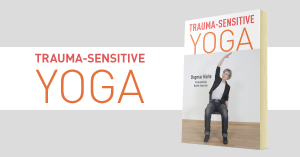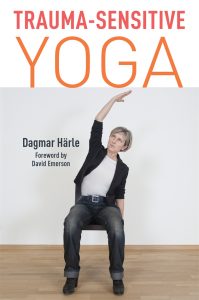In the second part of our Q&A with Dagmar Härle, she discusses how therapists can use trauma-sensitive yoga with their clients, and how to adapt their style of working with someone who has experienced trauma. You can read part one of the Q&A here. 
Why is it important that yoga teachers and therapists have an awareness of what positions might be potentially triggering for someone who has experienced any form of trauma?
Using yoga in the beginning of the process, we want to offer resources and foster self-efficacy and self-esteem. Offering postures with legs wide open like in happy baby where we lay on our back, holding the toes in our hands or buttocks unprotected like in a downward facing dog, for sexual traumatized people we have to be aware that those asanas can trigger. But avoiding these poses in the long-term doesn`t solve or heal because the patient cannot make new experiences like “I now can tolerate poses I couldn`t weeks ago”.
Holding people in their comfort zone ultimately doesn’t help them, or let them develop. It’s a matter of timing. Offer “safe” and easy asanas (always being aware that we don`t know what triggers may be) in the beginning and start to open up while the person makes good experiences and gains resources.
How important is flexibility or creativity in teaching style when working with people with a history of trauma?
Offering choice needs creativity. Flexibility is needed when an asana or breathing technique triggers and you want to offer another possibility.
Are there any disadvantages to using yoga with those affected by trauma?
The only disadvantage I can imagine is when trauma survivors don`t get a “trauma sensitive” yoga, e.g. when the one who offers yoga for this sensitive target group is not well trained. For instance we don`t touch people, we don`t direct people but use inviting language and offer choices instead of seeking the perfect form for the postures. In recent times, yoga has become very ambitious and the models on the internet and in books show asanas in perfection. For trauma survivors whose experience was that something or someone had control over them and their life in the moment, it could lead to pressure that they either try to please the teacher/therapist because it was significant to please the perpetrator and therefore will go over their limits instead of sensing their body and being in contact with themselves or they will dissociate and feel nothing, they just sustain and wait until it’s over like a traumatic situation. So aiming for a perfect form can erode important therapy goals like self-efficacy, sense of self and self-control. When we do yoga in a trauma-sensitive way we let people decide how they want to practice an asana.
Several studies show that exposure therapy is not only better tolerated, it also improves the effect of the therapy. And we should not forget, that a lot of people benefit not only in having less PTSD symptoms like hyperarousal, dissociation and numbness, hypervigilance, concentration problems, sleeping disorders and avoidance of trauma related triggers but many report that they take more care of themselves, they start to like their body instead of hating it and have (generally speaking) more quality of life. So there are many good reasons to combine trauma sensitive yoga with trauma therapy or to make use of yoga in general therapy as well.
Lastly, what do you hope readers will take away from your book?
When trauma therapists read my book I hope they learn the tools to make trauma therapy more tolerable and safer for the patients as well developing ideas for themselves on how to stay resilient and healthy. I also wish that it becomes clear how important language is: we can send therapeutic messages while teaching yoga asanas more effectively when we are aware of our wording. I also wish that readers start to bring the body into therapy using elements of trauma sensitive yoga for finding resources in the body.
Finding resources means that we seek postures or breathing patterns which help trauma survivors to calm down, sense their body in a safe way as well as end dissociation. Those positive experiences not only let trauma survivors feel more in control and self-confident, it also strengthens the relationship to the therapist because he or she is able to offer tools that work. Using trauma sensitive yoga for body related exposure means that we guide our patients into an asana and when it starts to get difficult we do not always support avoidance but support patients to explore the difficult sensations and emotions. For instance, if a patient senses constriction in the chest, restricted breathing and upcoming fear in a forward bend we suggest that he stays, if possible, a bit longer, observing what happens in the body and emotionally as well as reminding him that he has full control over the process and can lift his upper body whenever it’s getting too intense.
We do not force our patients but we also do not encourage avoidance because they will not gather new experiences like being able to face the fear and sensing, for example, that the constriction lowers and the fear decreases.
For trauma sensitive yoga teachers or those who want to learn how to work with trauma survivors, I hope they find a lot of inspiration, as well as examples of postures and language, in order to guide trauma survivors safely.
If you would like to read more articles like this and hear the latest news and offers on our books, why not join our mailing list? We can send information by email or post as you prefer, and please also tell us about your areas of interest so we can send the most relevant information. You can unsubscribe at any time.
Trauma-sensitive yoga is a body-based intervention for treating emotional responses to trauma and post-traumatic stress disorder. This book explains why yoga is a useful approach for trauma therapy and shows how to use this method in one-to-one and group settings. It also includes useful examples of non-triggering asanas and breathing exercises.
Click here to read more, or to buy the book.

1 Response